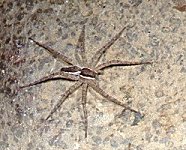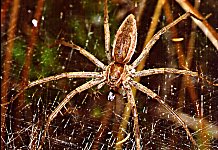|
Family: Pisauridae (nursery web or
fishing
spiders)
Life
> Eukaryotes
>
Opisthokonta >
Metazoa
(animals) > Bilateria > Ecdysozoa > Panarthropoda > Tritocerebra >
Arthropoda > Arachnomorpha > Cheliceriformes > Chelicerata > Euchelicerata
> Arachnida > Araneae
> Araneomorpha
In South Africa the Pisauridae include 14 genera, most of
which are diurnal. Some are web-bound and some not although they are all three
clawed spiders. The webs of the web bound species have no capture ability and
the spiders rely on speed to capture their prey. They are harmless to man.
Pisauridae is Latin, derived from an old Italian Town
"Pisaurum".
The family consists of two subfamilies. the Pisaurinae, or
nursery web spiders, with 12 genera indigenous to southern Africa, and the
Thalassinae, which includes the larger fishing spiders in the genera
Dolomedes and Thalassius.
Pisaurids are medium to very large arboreal-, terrestrial-
or water-associated spiders, ranging from 8 to 30 mm. The carapace is longer
than wide with the elongated abdomen tapering posteriorly. The legs are
relatively long and slender with numerous spines and depending on the genus, are
held forward and backward or latrigrade. The integument is normally coloured in
various shades of brown with lateral creamish bands on the carapace that may
extend along the abdomen. On some, the abdomen may be marked with spots or have
a folium (leaf-like marking). Others may have a lightish (brown, grey or cream)
median band running dorsally along both its carapace and abdomen.
All pisaurids construct a round white egg case that is
carried under the sternum held in the chelicerae (jaws). This causes them to
assume a tiptoe stance. Just before the eggs are due to hatch, the female
constructs a nursery web around the egg case. This is attached to the vegetation
with a supporting web around it. The spiderlings leave the nursery after one or
two moults.
There has been numerous publications on the biology of
fishing spiders but little is known about the nursery web spiders with
conflicting statements about whether they are web bound or active cursorial
hunters.
Genera indigenous to southern Africa
|
Subfamily: Pisaurinae (nursery web spiders) |
|
| |
Afropisaura |
|
| |
Charminus |
|
| |
Chiasmopes |
|
| |
Cispius
Rothus and Cispius are
two terrestrial genera that actively pursue prey, Cispius often using
its leaping powers to jump onto its prey. These spiders are typically marked
with lateral bands at least on the carapace and have numerous spines on the
long legs to aid with prey capture.
|
 |
| |
Euprosthenops |

|
| |
Euprosthenopsis |
|
| |
Maypacius |
|
| |
Perenethis |
|
| |
Rothus
Rothus and Cispius are
two terrestrial genera that actively pursue prey, Cispius often using
its leaping powers to jump onto its prey. These spiders are typically marked
with lateral bands at least on the carapace and have numerous spines on the
long legs to aid with prey capture. |
|
| |
Tapinothelella |
|
| |
Tetragonophthalma |
|
| |
Walrencea |
|
|
Subfamily: Thalassinae (fishing spiders) |
|
| |
Dolomedes |
|
| |
Thalassius
|

|
Text and images by Norman Larsen
©. |
